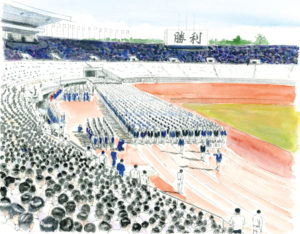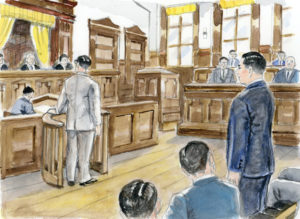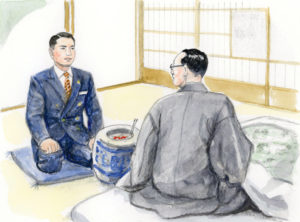Chapter Summary

Illustration courtesy of Seikyo Press.
On October 30 and November 1, one week after returning from Europe, Shin’ichi Yamamoto appeared before the Osaka District Court in connection with charges brought against him in what had come to be called the Osaka Incident. The trial was reaching its final stage.
On November 5, Shin’ichi attended the 10th young men’s division general meeting, which became a historic gathering of 100,000 young men at the National Sports Stadium. This meeting was actualized based on the vision and direction set forth by second Soka Gakkai President Josei Toda in a 1954 essay titled, “Youth, Be Patriotic!” Toda expressed his hopes that when 100,000 youthful patriots emerged, it would become possible to bring happiness to all who were suffering.
On a scoreboard above the stands, the young men had hung a gigantic banner emblazoned with the Chinese characters for “Victory!” Not only was this the Soka Gakkai’s theme for the following year, it also symbolized the triumph of these members who had worked so hard toward this day. Shin’ichi had been the youth division chief of staff when Mr. Toda published that essay. And he had been determined to actualize his mentor’s vision. Now, it had finally come to fruition.
One week later, the young women’s division held their ninth general meeting at Mitsuzawa Athletic Stadium with 85,000 representatives. Shin’ichi encouraged the young women to set a goal for all of its members to join the study department.[1]
On November 20, Shin’ichi traveled to the northeastern part of Japan to attend a completion ceremony for Soka Gakkai’s new Tohoku Headquarters building. He proposed to rename their regional song “Heroes of Tohoku” to “Song of the New Century,” so it could be sung nationwide.
Unforgettable Scene

Illustration courtesy of Seikyo Press.
Exposing the Prosecutor’s Lies
During the court sessions for the Osaka Incident trial, Shin’ichi Yamamoto exposed the false accusations of one of the prosecutors. Such efforts led to him being found innocent of all charges on January 25, 1962.
The chief prosecutor related the circumstances that had supposedly unfolded on the day of Shin’ichi’s release from custody: “Since early that morning, a crowd of around eight thousand had gathered at the Chuo Civic Hall. Then, all of a sudden, a group of them converged on the prosecutors office, crowding inside until the corridors were jam-packed … Then he told someone who happened to be standing nearby, ‘Make them leave!’ Inside of five minutes everyone had cleared out and the halls were empty.”
Now Shin’ichi rose to question the chief prosecutor: “In your testimony you stated that people crowded into the Public Prosecutors Office until the halls were jam-packed but that they left at once on my command. You seem to be implying that we were trying to put some sort of pressure on that office. But in what part of the Public Prosecutors Office building did this occur and how many people would you estimate came inside?”
The chief prosecutor hesitated for a moment, but then replied with false bravado, “I don’t know the exact number.”
“Well, then,” continued Shin’ichi, “where was I standing when I gave the order?”
The chief prosecutor was silent.
“Not one of the other prosecutors has testified to the events you describe. Have you made a mistake or are you lying?”
“I’m telling the truth,” the prosecutor muttered, despondently.
It was clear to everyone in the court that he was lying. Though the prosecutor had tried to secure Shin’ichi’s downfall, all he had succeeded in doing was to raise doubts in the judge’s mind about the veracity of the depositions the prosecution had obtained. (The New Human Revolution, vol. 5, pp. 151–52)

Illustration courtesy of Seikyo Press.
“One Hundred Thousand Patriots” Will Open a New Era
Shin’ichi Yamamoto’s mentor, Josei Toda, entrusted the youth with realizing the goal of gathering “100,000 patriots.” By December 1957, there were 78,000 young men’s division members, leading Shin’ichi to confidently declare that they would soon reach their goal.
In January 1958, Shin’ichi said to [second Soka Gakkai President Josei] Toda, “Sensei, this year we will reach our goal of 100,000 young men’s division members.”
“That’s wonderful!” Mr. Toda replied. Sitting up on his futon, his eyes radiating joy, he continued, “When 100,000 young men are united, they can achieve anything. The dawn of a new age for the people is coming.”
“Yes,” Shin’ichi agreed, “once we reach our goal, we will celebrate by gathering ‘100,000 patriots.’ I really want you to see it.”
“Yes, I’d like that, I’d like that very much,” Mr. Toda replied, nodding several times.
However, Josei Toda did not live to hear the announcement that his cherished dream had been achieved. He passed away on April 2, 1958. The young men’s division reached its target a little less than six months later, at the end of September. Shin’ichi was deeply disappointed that he could not have his mentor witness a dynamic gathering of 100,000 young men’s division members. He dearly wished that President Toda could have seen the combined strength and energy of the Soka Gakkai’s next generation of young men.
Together with Shin’ichi, the youth division chief of staff, these original 100,000 young men’s division members became a core of support for the Soka Gakkai. After Shin’ichi became president, they united with him even more solidly, working with one heart and mind to achieve an overall membership of 3 million households, initiating a powerful surge of growth and advancement …
Shin’ichi had been proposing for some time to the young men’s division leaders that they hold a meeting with 100,000 representatives to mark a fresh beginning for the youth who would build a new Soka Gakkai and usher in a new era for humanity. (NHR-5, 162–63)
Key Passage
Youth raise the curtain on a new era through their own capability and struggles. The stage upon which people of genuine courage perform is not prepared by others, no matter how magnificent it may be. (NHR-5, 207)
References
- In the 1960s, members had to first pass an entrance examination to become a member of the study department. ↩︎
You are reading {{ meterCount }} of {{ meterMax }} free premium articles

